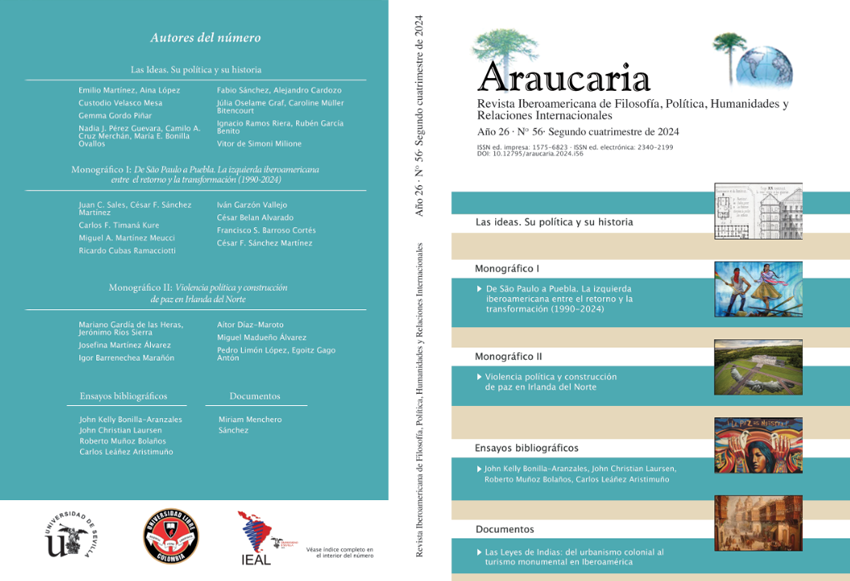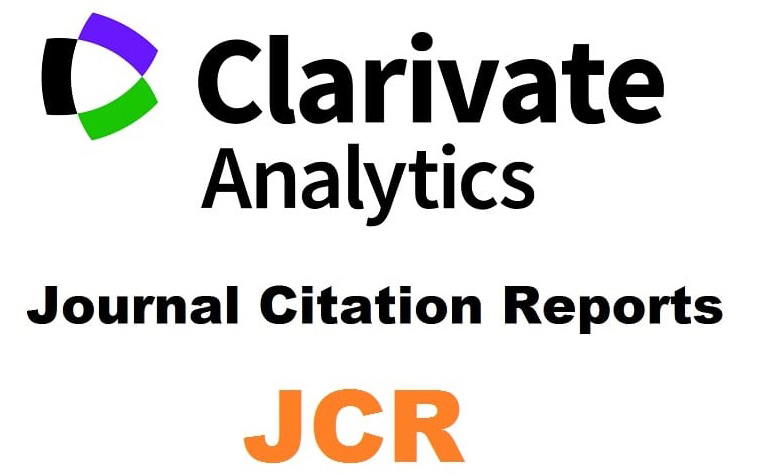La evolución de la figura materna en las películas sobre el conflicto irlandés
The evolution of the image of the mother in films about the Irish conflicto
DOI:
https://doi.org/10.12795/araucaria.2024.i56.18Palabras clave:
Maternidad, Mujeres, Irlanda, Terrorismo, Cinematografía, Violencia política, Irlanda del Norte, IRAResumen
Los cineastas han definido unos estereotipos femeninos y maternos en aquellos filmes dedicados a la violencia política irlandesa desde 1926. La fuerte retórica nacionalista de estas películas ha mantenido casi inmutables los atributos de las madres como mímesis de la patria. Al iniciarse los Procesos de Paz en 1996 y tras la firma de los Acuerdos de Viernes Santo de 1998, directores y guionistas han enriquecido sus narrativas para mostrar la presencia de las mujeres en la esfera pública. La producción de estas películas, realizada en tres países diferentes, Irlanda, Gran Bretaña y Estados Unidos, ha determinado los modelos de la maternidad en consonancia con el imaginario colectivo de los diferentes públicos, influyendo a su vez en la construcción del relato sobre el conflicto armado y las mujeres.
Descargas
Citas
Juan Avilés, José Manuel Azcona, Matteo Re, (eds.), Después del 68: la deriva terrorista en Occidente, Madrid, Silex, 2019.
Ruth Barton, Jim Sheridan: Framing the Nation, Dublin, The Liffey Press, 2002.
Ruth Barton, Irish National Film, London, Routledge, 2004.
Bowyer Bell, The Secret Army: The IRA, 1916-1979, Dublin, Academy Press, 1979. Disponible en: < https://archive.org/details/secretarmyira1910000bell_t4b3/page/n7/mode/2up > [Última consulta, 6 de mayo de 2024].
Jennie Carlsten, “Mourning and solidarity: The commemorative models of Some Mother’s Son and H3”, [en Brian McIlroy (ed.), Genre and Cinema: Ireland and Transnationalism, 2012], London, Routledge, pp. 233–44.
Mark Connelly, The IRA on Film and Television: A History. Jefferson, McFarland & Company, 2012.
Elizabeth Cullingford, “Gender, Sexuality and Englishness in Modern Irish Drama and Film”, [en Anthony Bradley y Maryanne Gialanella Valiulis (eds), Gender and Sexuality in Modern Ireland, University of Massachusetts Press. 1997], pp. 159-186.
S. J. Edge, “Feisty Colleens or Mother Ireland: Representations of Women in Irish Cinema”, Fortnight, 379, (1999), pp. 8-10. Disponible en: <https://core.ac.uk/reader/147598350> [Última consulta, 6 de mayo de 2024].
Richard Gallagher, Screening Ulster: Cinema and the Unionists, Cham, Palgrave Macmillan, 2023.
John Hill, Cinema and Northern Ireland. Film, Culture and Politics, London, Palgrave Macmillan, 2006.
Declan Kiberd, Inventing Ireland (Convergences), Cambridge, Harvard University Press, 1996.
Orla Lynch, Javier Argomaniz, Victims and Perpetrators of Terrorism. Exploring Identities, Roles and Narratives, London, Routledge, 2019.
Catherine Lynette Innes, Woman and Nation in Irish Literature and Society, 1880-1935, Hoboken, Prentice-Hall, 1993.
Gerry Kearns, “Mother Ireland and the revolutionary sisters”, Cultural Geographies, 11/44 (2004), pp. 443-467. Disponible en: <https://doi.org/10.1191/1474474004eu315oa> [Última consulta, 6 de mayo de 2024].
Josefina Martínez Álvarez, “La representación cinematográfica de las mujeres víctimas del terrorismo durante los años de la lucha armada (1968-2001)” [en Laura González Piote, Alfredo Crespo Alcázar, José Luis Rodríguez Jiménez, coords.: Mujeres víctimas del terrorismo y mujeres contra el terrorismo. Historia, memoria, labor y legado, Madrid, Dykinson, 2022a], pp. 127-147.
Josefina Martínez Álvarez, “Ellas siempre estuvieron ahí. El tratamiento cinematográfico de las mujeres víctimas del terrorismo” [en José Manuel Azcona Pastor, ed.: El discurso de ETA, la internacionalización del terror y la ficción audiovisual, Madrid, Silex, 2022b], pp. 233-262. Disponible en: <http://e-spacio.uned.es/fez/eserv/bibliuned:DptoHC-FGH-Caplibros-Jmartinez-0003/ELLAS-SIEMPRE-ESTUVIERON-ALL__-2022-SILEX.pdf> [Última consulta, 6 de mayo de 2024].
Josefina Martínez Álvarez, “De la invisibilidad a la reparación: el largo camino de las mujeres víctimas del terrorismo y su construcción en el cine” en Araucaria. Revista de Filosofía, Política y Humanidades, 24/50 (2022c), pp. 184-204. Disponible en: <https://revistascientificas.us.es/index.php/araucaria/article/view/18834> [Última consulta, 6 de mayo de 2024].
Arthur Marwick, The Sixties: Cultural Revolution in Britain, France, Italy and the United States, c. 1958-c. 1974, Oxford, Oxford Paperbacks, 1998.
Sinéad McCoole, No Ordinary Women: Irish Female Activists in the Revolutionary Years 1900-1923, Dublin, The O’Brien Press, 2003.
Brian McIlroy, Shooting to Kill: Filmmaking and the “Troubles” in Northern Ireland, Richmond, Steveston Press, 2001.
Anthony McIntyre, “Statistics of the Conflict and Conflict of Statistics”, en The Pensive Quill, (2011), <https://www.thepensivequill.com/2011/11/statistics-of-conflict-and-conflict-of.html?m=0> [Última consulta, 6 de mayo de 2024].
Martin McLoone, Kevin Rockett, Irish Films, Global Cinema: Studies in Irish Film 4, Dublin, Four Courts Press, 2007.
Raita Merivirta, “Gendered Conflicts in Northern Ireland: Motherhood, the Male Body and Borders in Some Mother’s Son and Hunger” [en Kimmo Ahonen, Heta Mulari, Rami Mähkä, Frontiers of Screen History: Imagining European Borders in Cinema, 1945-2010. Bristol, Intellect, 2013], Disponible en: <https://pdf-to-word.obar.info/> [Última consulta, 6 de mayo de 2024].
Catherine Nash, “Remapping and Renaming: New Cartographies of Identity, Gender and Landscape in Ireland”, Feminist Review’s, 44 (1993), pp. 39-57. Disponible en: <https://doi.org/10.1057/fr.1993.19> [Última consulta, 6 de mayo de 2024].
John O'Beirne Ranelagh, Historia de Irlanda, Madrid, Akal, 2014.
Barbara O’Connor, “Aspects of Representation of Women in Irish Film”, The Crane Bag, 8/2 (1984), pp. 79-83. Disponible en: <https://www-jstor-org.bibliotecauned.idm.oclc.org/stable/30023282?seq=2 > [Última consulta, 6 de mayo de 2024].
Michael Parsons, “An Irishman’s Dairy”, The Irish Times, 11 de marzo de 2006, Disponible en: <https://www.irishtimes.com/opinion/an-irishman-s-diary-1.1027041 > [Última consulta, 6 de mayo de 2024].
Kevin Rockett, Irish Film Censorship: A Cultural Journey from Silent Cinema to Internet Pornography, Dublin, Four Courts Press, 2004.
Marcos Rojo, “El terrorismo en el cine”, Revista Aequitas, 3 (2013), pp. 253-304.
Gerardine Meaney, “Landscapes of Desire: Women and Ireland on Film”. Women: a cultural review, 9/3 (1998), pp. 237-251. Disponible en: <https://www.tandfonline.com/doi/abs/10.1080/09574049808578355> [Última consulta, 6 de mayo de 2024].
Malcolm Sutton, An Index of Deaths from the Conflict in Ireland, (2001), <http://cain.ulst.ac.uk/sutton/tables/Year.html> [Última consulta, 6 de mayo de 2024].
Ann Owens Weekes, “Figuring the Mother in Contemporary Irish Fiction”, [en L. Harte y M. Parker, (eds), Contemporary Irish Fiction. London, Palgrave Macmillan, 2000], pp. 100-124.
David C. Rapoport, Terrorism Critical Concepts in Political Science, New York, Routledge, 2006.
Peter Taylor, Provos. The IRA & Sinn Féin, London, Bloomsbury Publishing, 1997, pp. 251-252. Disponible en: <https://archive.org/details/provosirasinnfei0000tayl/page/n7/mode/2up> [Última consulta, 6 de mayo de 2024].
Pilar Villar-Argáiz, “Latter-day Mother Irelands: The Role of Women in Michael Collins and The Wind that Shakes the Barley”, Estudios Irlandeses, 2 (2007), pp. 183-204. Disponible en: <https://www.estudiosirlandeses.org/wp-content/uploads/2013/05/MotherIrelandsPilarVillar.pdf> [Última consulta, 6 de mayo de 2024].
Descargas
Publicado
Cómo citar
Número
Sección
Licencia
Las ediciones impresa y electrónica de esta Revista son editadas por el Secretariado de Publicaciones de la Universidad de Sevilla, siendo necesario citar la procedencia en cualquier reproducción parcial o total.Salvo indicación contraria, todos los contenidos de la edición electrónica se distribuyen bajo una licencia de uso y distribución “Creative Commons Atribución-NoComercial-SinDerivar 4.0 Internacional”








